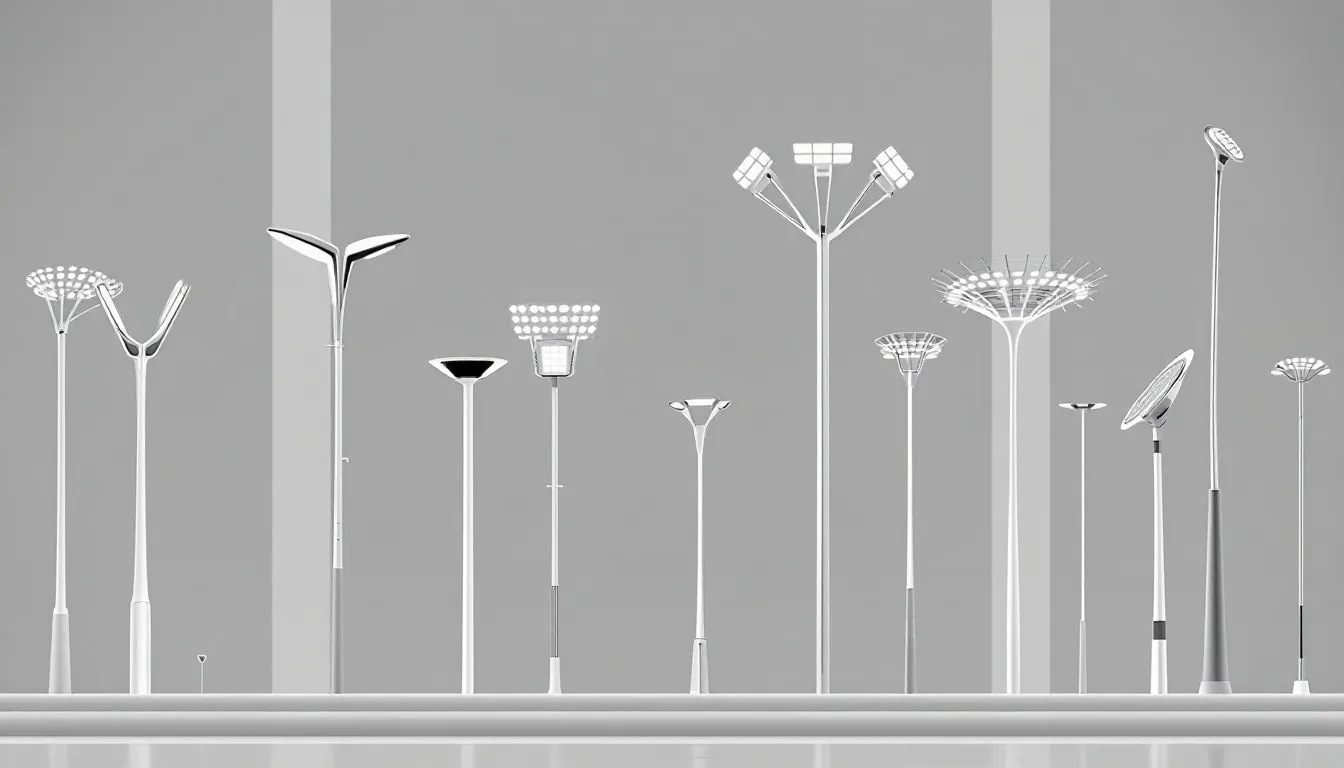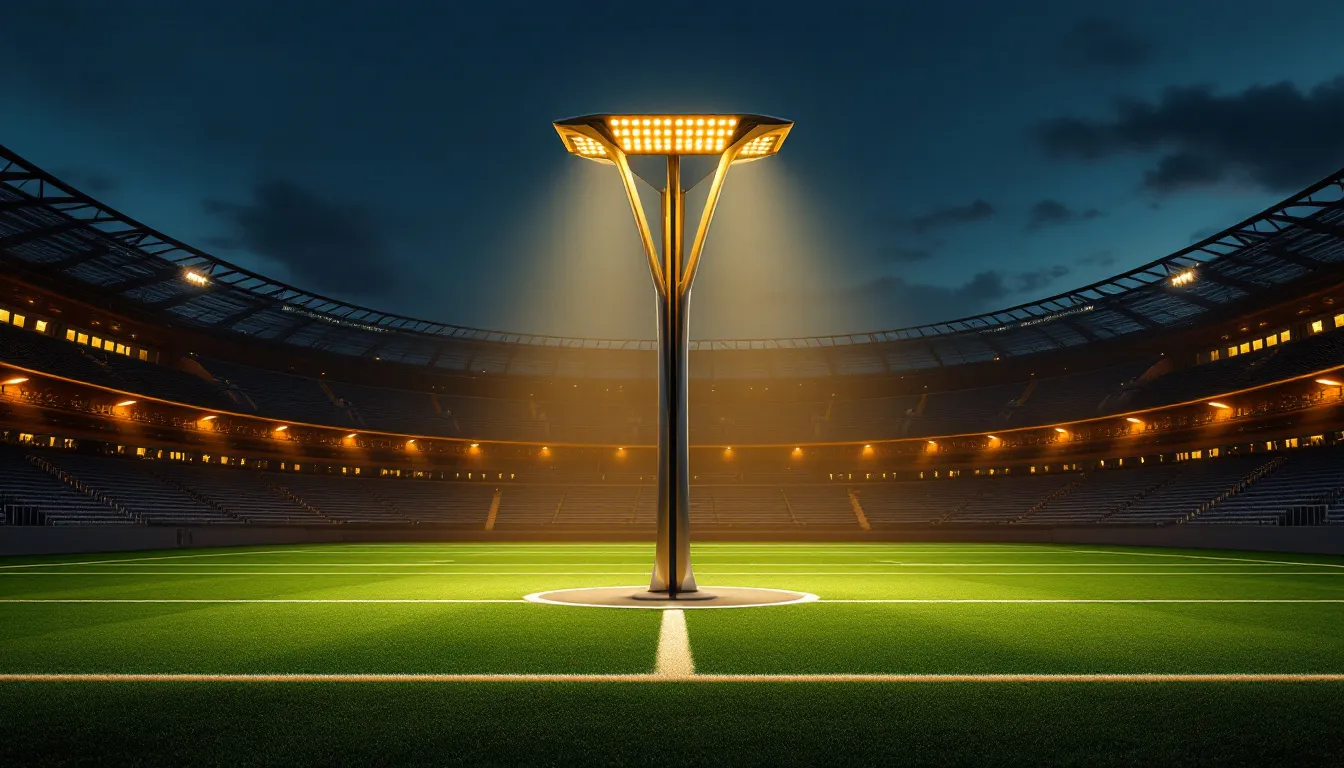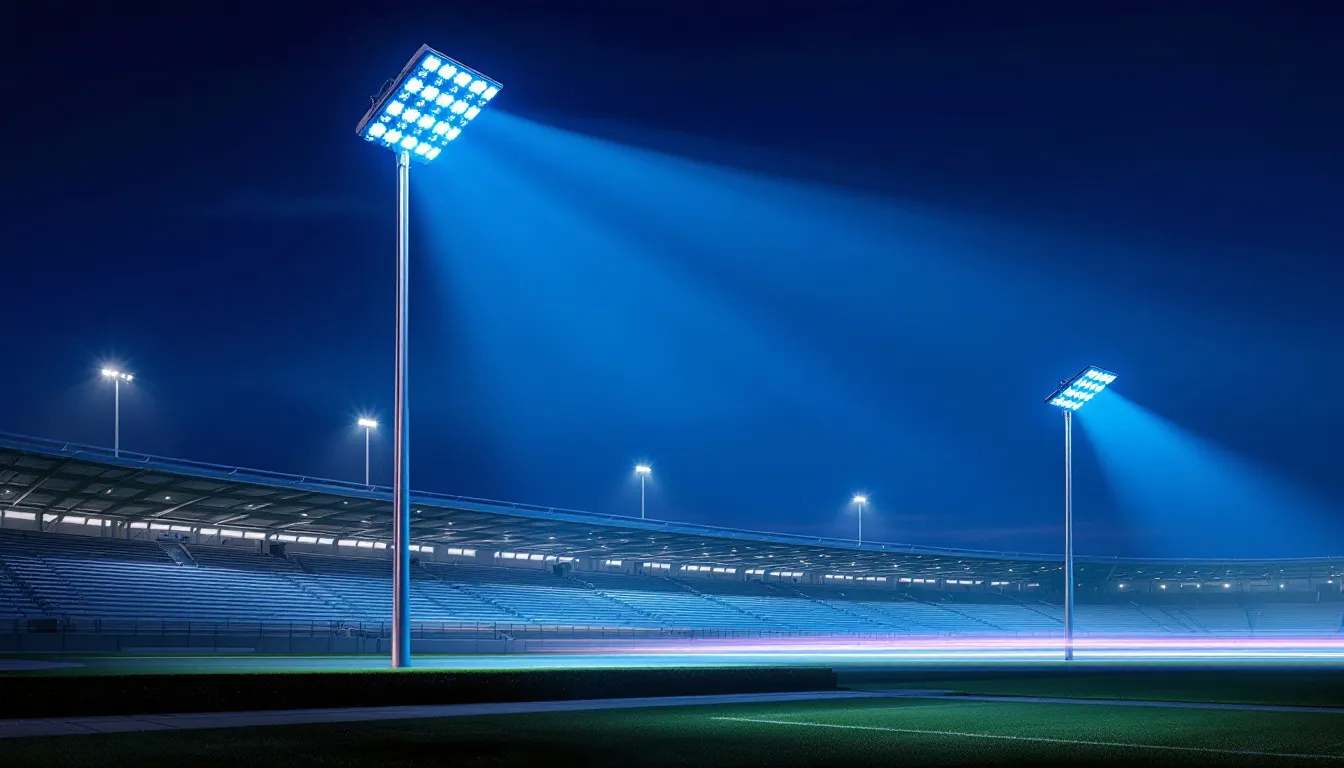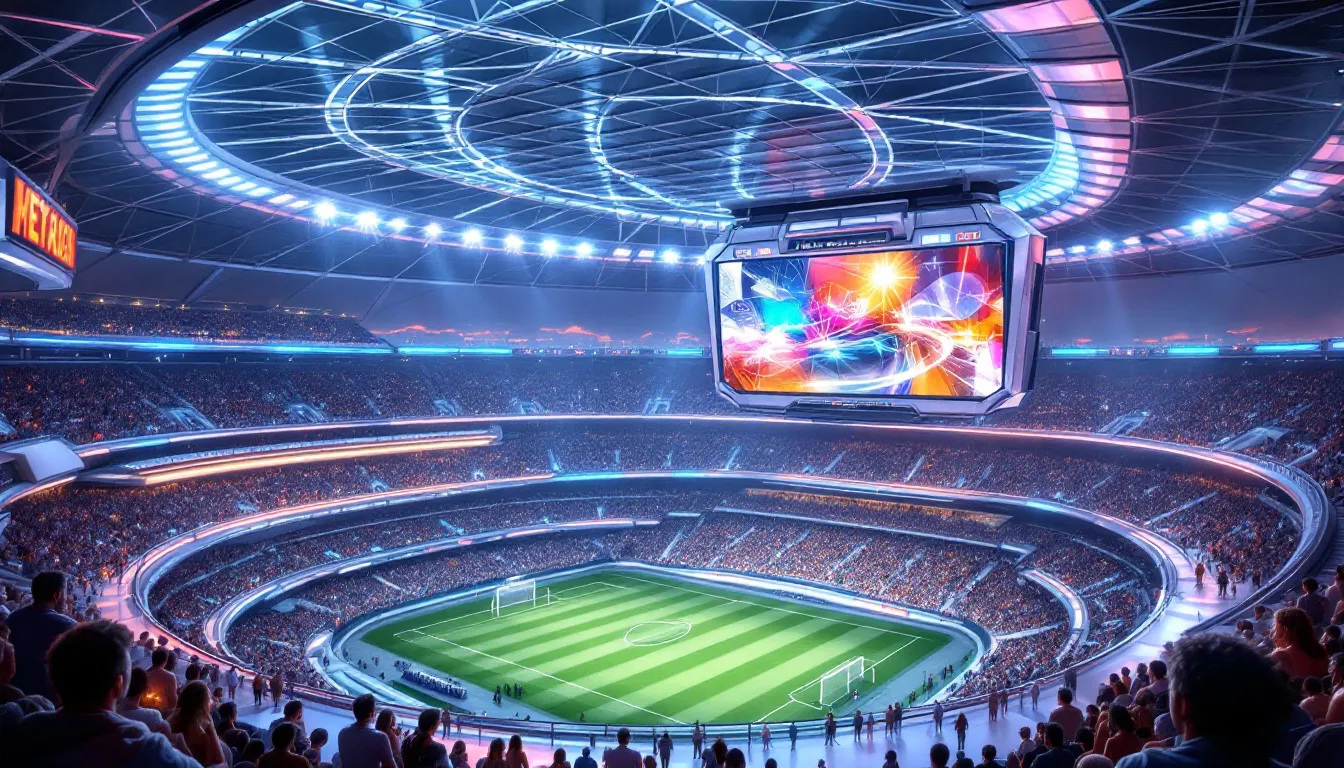Choosing a stadium light pole involves considering its type, cost, and maintenance. In this article, we’ll guide you through these aspects to help you make an informed decision.
Key Takeaways
-
- Stadium light poles vary in type, including high mast, fixed, mid-hinged, and lifting poles, each suited for specific applications based on height and maintenance needs.
- Cost factors for stadium light poles include material choice, height, load capacity, and additional features, which can significantly impact both initial investment and long-term maintenance requirements.
- Compliance with local regulations, proper installation, and routine maintenance are crucial for ensuring the safety, effectiveness, and longevity of stadium lighting systems.
Types of Stadium Light Poles
Understanding the different types of sports lighting poles and their specific applications is crucial. A high mast pole is typically used to illuminate large areas, standing over 15 meters tall and providing a lighting radius of up to 60 meters. These poles are ideal for professional stadiums and large sports complexes where broad, uniform illumination is required.
Fixed light poles, on the other hand, are commonly used in stadiums and can reach heights within a range of 15 to 18 meters. They are designed to support a limited number of light fixtures, making them suitable for smaller venues or specific parts of larger stadiums.
Mid-hinged poles offer the advantage of easier maintenance, as they can be lowered horizontally to the ground for lamp replacement and repairs, addressing the need for accessible maintenance without the use of cranes or extensive equipment, bending the traditional methods of maintenance.
Lifting poles are another versatile option, featuring an internal mechanism that allows the light panel to be elevated or lowered. This design facilitates both installation and maintenance, ensuring that light fixtures are always within reach. Each type of pole caters to specific needs, ranging from the broad illumination provided by high-mast poles to the easier maintenance of mid-hinged and lifting poles.
Cost Factors for Stadium Light Poles
Several key factors influence the cost of stadium light poles. Material choice is one of the most significant considerations, with options like steel, aluminum, and fiberglass each offering different benefits and price points. For instance, steel poles are known for their strength and durability, making them a popular choice for environments requiring robust structural support. However, they do require regular maintenance to prevent rust and corrosion.
The height of the pole significantly impacts the cost. Taller poles generally require more material and engineering, which increases both the material and installation expenses. Additionally, the load capacity of a pole, which determines how many fixtures it can support and its ability to withstand wind forces, can significantly impact the overall cost. Poles designed to support heavier loads or withstand higher winds are typically more expensive due to the need for more robust construction.
Additional features like powder coating for corrosion resistance or the inclusion of cross arms to support multiple fixtures further add to the total expense of stadium light poles. These enhancements, while increasing the initial cost, can offer long-term benefits by extending the lifespan of the poles and reducing maintenance needs.
Optimal Pole Height for Stadium Lighting
Selecting the right pole height is crucial for ensuring optimal stadium lighting. Consistent illumination across the playing field is essential for fair play and improving the viewing experience for spectators. The height of the poles must be chosen based on the specific lighting needs of different sports, as each sport has unique requirements for visibility and coverage.
For instance, football fields and soccer fields may require different pole heights compared to baseball fields or other sports venues. The guidelines for pole height should take into account the size of the playing field, the level of competition, and the types of fixtures used. Proper pole height not only enhances the experience for players by minimizing shadows and ensuring even lighting but also improves the overall atmosphere for spectators.
Ultimately, the right pole height plays a significant role in creating a positive experience for everyone involved, from players to fans on the football field. It ensures that the field is well-lit, reducing the risk of accidents and enhancing the visual quality of the game.
Material Options: Aluminum vs. Steel vs. Fiberglass
Material choice for stadium light poles greatly affects their functionality, durability, and maintenance requirements. Durable aluminum poles are lightweight and resistant to corrosion, making them ideal for various installations, especially in coastal areas where salt exposure is a concern. These poles can have a lifespan exceeding 50 years, offering long-term reliability and minimal maintenance.
Steel poles are valued for their strength and durability, making them a popular choice for environments that require robust structural support. Although they are more affordable initially, steel poles require regular maintenance to prevent rust and corrosion, which can add to their long-term costs.
On the other hand, fiberglass poles offer advantages in corrosion resistance and safety due to their non-conductive nature, making them a suitable alternative for environments with high salt exposure or electrical hazards.
Choosing the right material involves weighing the benefits and drawbacks of each option. Aluminum offers longevity and low maintenance, steel provides strength and durability, and fiberglass ensures safety and corrosion resistance. Each material has its specific applications and advantages, which need to be considered based on the specific needs of the lighting project.
Compliance with Local Regulations
Adhering to local regulations is crucial when installing stadium light poles. Height restrictions for light poles vary by municipality, necessitating consultation of local guidelines before installation. These regulations may dictate not only the height of the poles but also their placement and spacing, impacting the overall design of the facility.
Wind load specifications are another crucial factor to consider, especially in areas with high wind speeds. Poles must be designed to withstand these forces to prevent structural failure and ensure safety. Following engineering standards and local regulations is key for the safety, performance, and durability of light poles.
Compliance with local building codes and ordinances requires detailed planning and expert consultation in form. This step is vital to guarantee that the minimum lighting system is not only effective but also reliable and safe for use in all weather conditions.
Installation and Maintenance Essentials
Correct installation and maintenance ensure the longevity and performance of stadium light poles. Many poles are pre-drilled for easy install, allowing for standard hardware compatibility and reducing installation time. The condition of the existing electrical infrastructure can also influence the cost and complexity of the project, as upgrades may be needed to support modern lighting systems.
Regular maintenance practices, such as cleaning light fixtures and poles, are necessary to maintain their efficiency by removing contaminants that hinder performance. Conducting regular inspections can help identify damage or wear early, allowing for timely repairs and preventing more significant issues. Replacing worn components, such as light fixtures and electrical connections, is crucial for maintaining the lighting system’s effectiveness.
Routine electrical checks ensure the safety and efficiency of the lighting system. Identifying issues like loose connections and faulty wiring can prevent potential hazards and ensure that the lighting remains reliable and effective throughout its lifespan. An inspection can help in this process.
Benefits of LED Lighting with Stadium Light Poles
LED lighting has revolutionized stadium illumination. LED lights can reduce energy consumption by up to 75%, significantly lowering operational costs. This energy efficiency, combined with a longer lifespan and durability, makes LED lighting a practical choice for modern stadiums.
LED lighting technology provides clearer and more efficient illumination, enhancing the visual quality of both live events and broadcasts. The durability of led light ensures consistent performance, reducing the need for frequent maintenance and replacements. As conventional lighting options become less available, LEDs are becoming the standard for new installations.
Using LED lighting with stadium light poles offers numerous benefits, including energy savings, enhanced illumination quality, and reduced maintenance needs. These advantages make LED systems an ideal choice for both new installations and upgrades to existing lighting systems.
Understanding Wind Load Capacity
Knowing wind load capacity is vital for the structural integrity and safety of stadium light poles. To determine wind load, factors like the frontal projected area, drag coefficient, and wind speed must be considered. Calculating the drag coefficient helps assess how much wind pressure a pole’s components can endure.
High-performance poles are designed to withstand severe wind conditions without compromising safety. Ensuring that the pole design can handle the wind load is essential for preventing structural failure and maintaining the safety of the lighting system.
Consulting specialists or using online calculators ensures accurate wind load calculate. This step is vital to ensure that the poles are properly balanced and capable of withstanding the environmental conditions they will face, maintaining their balance.
The Role of Cross Arms in Stadium Lighting
Cross arms are crucial for supporting lighting fixtures and ensuring they remain stable and properly aligned at the correct angle for optimal light distribution. These signs components are engineered to withstand harsh weather conditions, enhancing their reliability and longevity.
Cross arms help distribute the weight of lighting fixtures, balancing loads to maintain structural integrity. Properly designed cross arms are essential for ensuring that the lighting system provides consistent and effective illumination across the entire playing field.
Enhancing Spectator Experience with Proper Stadium Lighting
Quality stadium lighting significantly influences the overall atmosphere of events, making them more exhilarating for spectators. The psychological effects of lighting, including mood enhancement, contribute to a more engaging environment for fans. LED lighting enhances the visual quality of broadcasts, making sporting events more appealing for television coverage.
Good lighting also enhances safety by reducing the risk of accidents and ensuring proper navigation for both players and fans. The strategic arrangement of sports light helps minimize shadows, allowing athletes to maintain focus and improve performance. Illuminating lighting can be adjusted dynamically to enhance the experience during special moments, such as halftime shows.
By providing clear, consistent illumination, proper stadium lighting ensures a better experience for spectators, players, and broadcasters alike. The use of advanced lighting technology helps create a vibrant and engaging atmosphere, making every event memorable.
Summary
Choosing the best stadium light pole involves considering various factors, from the types of poles available to the materials used and the importance of compliance with local regulations. Each type of pole, whether high-mast, fixed, mid-hinged, or lifting, has its specific applications and benefits. Material choices, such as aluminum, steel, and fiberglass, offer different advantages in terms of durability, maintenance, and cost.
Proper installation and maintenance are crucial for the longevity and performance of the lighting system. Regular inspections, timely repairs, and routine maintenance practices ensure that the system remains efficient and reliable. The shift towards LED lighting offers significant benefits, including energy efficiency, enhanced illumination quality, and reduced maintenance needs.
Ultimately, understanding the various aspects of stadium lighting, from wind load capacity to the role of cross arms, helps create a safe, efficient, and engaging environment for both players and spectators. By making informed decisions, you can ensure that your stadium lighting project meets all necessary standards and provides an exceptional experience for everyone involved.
Frequently Asked Questions
What are the different types of stadium light poles?
The different types of stadium light poles include high-mast poles, fixed light poles, mid-hinged poles, and lifting poles, each serving distinct purposes and maintenance requirements. Understanding these types helps ensure proper lighting solutions for various sporting events and facilities.
How do material choices affect the cost and maintenance of light poles?
Material choices significantly influence both the cost and maintenance of light poles. Steel, while strong, incurs higher maintenance expenses due to corrosion, whereas aluminum, being lightweight and corrosion-resistant, along with fiberglass, which is durable and non-conductive, generally results in lower long-term maintenance costs.
Why is pole height important for stadium lighting?
Pole height is essential for achieving uniform lighting across the stadium, which enhances visibility for players and spectators alike. It also affects the overall cost and structural integrity of the lighting system.
What are the benefits of using LED lights in stadiums?
Utilizing LED lights in stadiums provides energy efficiency, a long lifespan, superior illumination quality, and lower maintenance requirements, making them an optimal choice for contemporary lighting solutions.
How can proper stadium lighting enhance the spectator experience?
Proper stadium lighting significantly enriches the spectator experience by improving visual clarity and safety while enhancing the atmosphere for events. This dynamic lighting also allows for special effects, making the experience more engaging and memorable.




